

Compact Muon Solenoid
LHC, CERN
| CMS-EXO-19-005 ; CERN-EP-2019-185 | ||
| Search for long-lived particles using delayed photons in proton-proton collisions at $\sqrt{s} = $ 13 TeV | ||
| CMS Collaboration | ||
| 13 September 2019 | ||
| Phys. Rev. D 100 (2019) 112003 | ||
| Abstract: A search for long-lived particles decaying to photons and weakly interacting particles, using proton-proton collision data at $\sqrt{s} = $ 13 TeV collected by the CMS experiment in 2016-2017 is presented. The data set corresponds to an integrated luminosity of 77.4 fb$^{-1}$. Results are interpreted in the context of supersymmetry with gauge-mediated supersymmetry breaking, where the neutralino is long-lived and decays to a photon and a gravitino. Limits are presented as a function of the neutralino proper decay length and mass. For neutralino proper decay lengths of 0.1, 1, 10, and 100 m, masses up to 320, 525, 360, and 215 GeV are excluded at 95% confidence level, respectively. We extend the previous best limits in the neutralino proper decay length by up to one order of magnitude, and in the neutralino mass by up to 100 GeV. | ||
| Links: e-print arXiv:1909.06166 [hep-ex] (PDF) ; CDS record ; inSPIRE record ; CADI line (restricted) ; | ||
| Figures | |

png pdf |
Figure 1:
Example Feynman diagrams for SUSY processes that result in a diphoton (left) and single photon (middle and right) final state via squark (upper) and gluino (lower) pair-production at the LHC. |

png pdf |
Figure 1-a:
Example Feynman diagrams for SUSY processes that result in a diphoton (left) and single photon (middle and right) final state via squark (upper) and gluino (lower) pair-production at the LHC. |

png pdf |
Figure 1-b:
Example Feynman diagrams for SUSY processes that result in a diphoton (left) and single photon (middle and right) final state via squark (upper) and gluino (lower) pair-production at the LHC. |

png pdf |
Figure 1-c:
Example Feynman diagrams for SUSY processes that result in a diphoton (left) and single photon (middle and right) final state via squark (upper) and gluino (lower) pair-production at the LHC. |

png pdf |
Figure 1-d:
Example Feynman diagrams for SUSY processes that result in a diphoton (left) and single photon (middle and right) final state via squark (upper) and gluino (lower) pair-production at the LHC. |

png pdf |
Figure 1-e:
Example Feynman diagrams for SUSY processes that result in a diphoton (left) and single photon (middle and right) final state via squark (upper) and gluino (lower) pair-production at the LHC. |
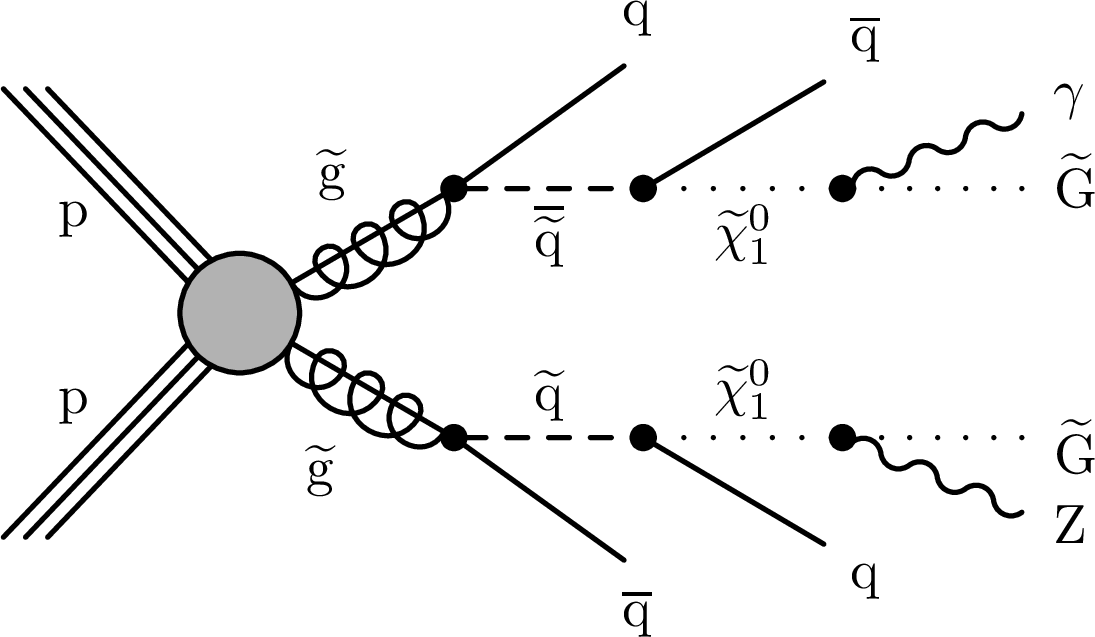
png pdf |
Figure 1-f:
Example Feynman diagrams for SUSY processes that result in a diphoton (left) and single photon (middle and right) final state via squark (upper) and gluino (lower) pair-production at the LHC. |
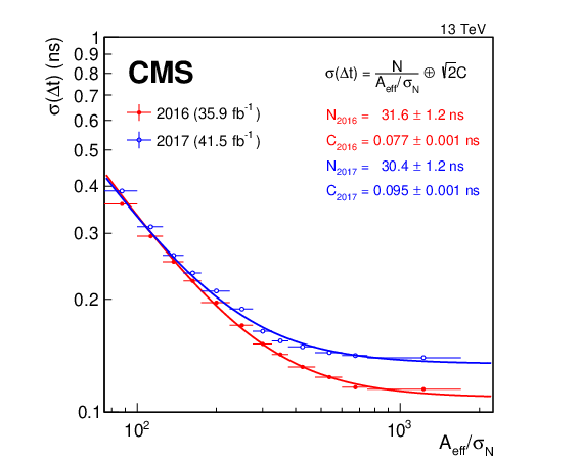
png pdf |
Figure 2:
The time resolution between two neighboring ECAL crystals as a function of the effective amplitudes of the signals in the two crystals for the 2016 and 2017 data sets. The lines shown reflect the fits described in the text. |

png pdf |
Figure 3:
The ${{p_{\mathrm {T}}} ^\text {miss}}$ (left) and ${t_{\gamma}}$ (right) distributions for the 2016 event selection, shown for data and a representative signal benchmark (GMSB: $\Lambda =$ 200 TeV, ${c\tau}=$ 2 m). The ${{p_{\mathrm {T}}} ^\text {miss}}$ distribution for data is separated into events with $ {t_{\gamma}}\geq $ 1 ns (blue, darker) and $ {t_{\gamma}} < $ 1 ns (red, lighter), scaled to match the total number of events with $ {t_{\gamma}}\geq $ 1 ns. Signal (black, dotted) is shown only for events with $ {t_{\gamma}}\geq $ 1 ns. The ${t_{\gamma}}$ distribution for data is separated into events with $ {{p_{\mathrm {T}}} ^\text {miss}} \geq $ 100 GeV (blue, darker) and $ {{p_{\mathrm {T}}} ^\text {miss}} < $ 100 GeV (red, lighter), scaled to match the total number of events with $ {{p_{\mathrm {T}}} ^\text {miss}} \geq $ 100 GeV. Signal (black, dotted) is shown only for events with $ {{p_{\mathrm {T}}} ^\text {miss}} \geq $ 100 GeV. The entries in each bin are normalized by the bin width. The horizontal bars on data indicate the bin boundaries. The last bin in each plot includes overflow events. |
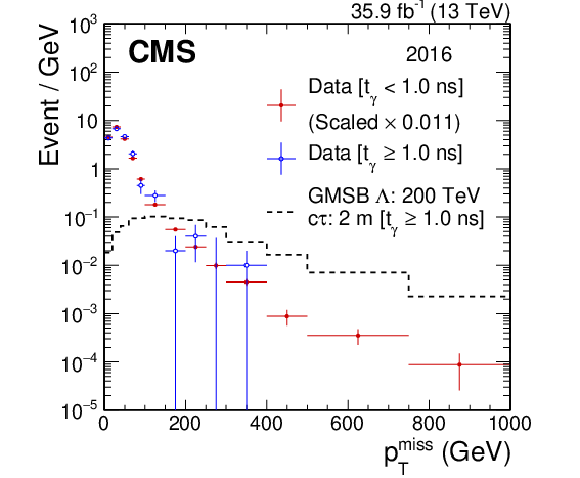
png pdf |
Figure 3-a:
The ${{p_{\mathrm {T}}} ^\text {miss}}$ distribution for the 2016 event selection, shown for data and a representative signal benchmark (GMSB: $\Lambda =$ 200 TeV, ${c\tau}=$ 2 m). The ${{p_{\mathrm {T}}} ^\text {miss}}$ distribution for data is separated into events with $ {t_{\gamma}}\geq $ 1 ns (blue, darker) and $ {t_{\gamma}} < $ 1 ns (red, lighter), scaled to match the total number of events with $ {t_{\gamma}}\geq $ 1 ns. Signal (black, dotted) is shown only for events with $ {t_{\gamma}}\geq $ 1 ns. The ${t_{\gamma}}$ distribution for data is separated into events with $ {{p_{\mathrm {T}}} ^\text {miss}} \geq $ 100 GeV (blue, darker) and $ {{p_{\mathrm {T}}} ^\text {miss}} < $ 100 GeV (red, lighter), scaled to match the total number of events with $ {{p_{\mathrm {T}}} ^\text {miss}} \geq $ 100 GeV. Signal (black, dotted) is shown only for events with $ {{p_{\mathrm {T}}} ^\text {miss}} \geq $ 100 GeV. The entries in each bin are normalized by the bin width. The horizontal bars on data indicate the bin boundaries. The last bin includes overflow events. |
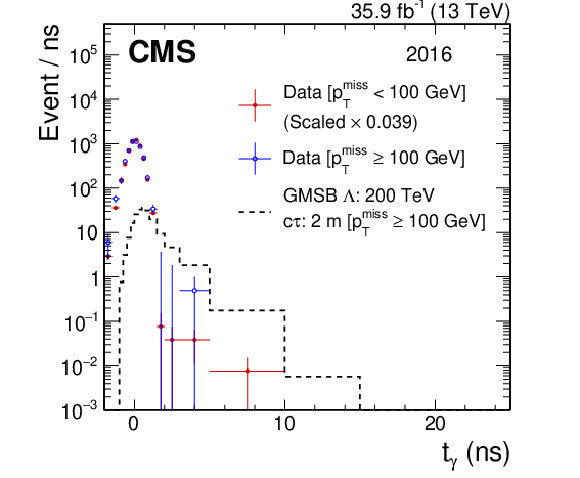
png pdf |
Figure 3-b:
The ${t_{\gamma}}$ distribution for the 2016 event selection, shown for data and a representative signal benchmark (GMSB: $\Lambda =$ 200 TeV, ${c\tau}=$ 2 m). The ${{p_{\mathrm {T}}} ^\text {miss}}$ distribution for data is separated into events with $ {t_{\gamma}}\geq $ 1 ns (blue, darker) and $ {t_{\gamma}} < $ 1 ns (red, lighter), scaled to match the total number of events with $ {t_{\gamma}}\geq $ 1 ns. Signal (black, dotted) is shown only for events with $ {t_{\gamma}}\geq $ 1 ns. The ${t_{\gamma}}$ distribution for data is separated into events with $ {{p_{\mathrm {T}}} ^\text {miss}} \geq $ 100 GeV (blue, darker) and $ {{p_{\mathrm {T}}} ^\text {miss}} < $ 100 GeV (red, lighter), scaled to match the total number of events with $ {{p_{\mathrm {T}}} ^\text {miss}} \geq $ 100 GeV. Signal (black, dotted) is shown only for events with $ {{p_{\mathrm {T}}} ^\text {miss}} \geq $ 100 GeV. The entries in each bin are normalized by the bin width. The horizontal bars on data indicate the bin boundaries. The last bin includes overflow events. |

png pdf |
Figure 4:
The ${{p_{\mathrm {T}}} ^\text {miss}}$ (left) and ${t_{\gamma}}$ (right) distributions for the 2017$\gamma$ (upper row) and 2017$\gamma \gamma$ (lower row) event selections shown for data and a representative signal benchmark (GMSB: $\Lambda =$ 200 TeV, ${c\tau}=$ 2 m). The ${{p_{\mathrm {T}}} ^\text {miss}}$ distribution for data is separated into events with $ {t_{\gamma}}\geq $ 1 ns (blue, darker) and $ {t_{\gamma}} < $ 1 ns (red, lighter), scaled to match the total number of events with $ {t_{\gamma}}\geq $ 1 ns. Signal (black, dotted) is shown only for events with $ {t_{\gamma}}\geq $ 1 ns. The ${t_{\gamma}}$ distribution for data is separated into events with $ {{p_{\mathrm {T}}} ^\text {miss}} \geq $ 100 GeV (blue, darker) and $ {{p_{\mathrm {T}}} ^\text {miss}} < $ 100 GeV (red, lighter), scaled to match the total number of events with $ {{p_{\mathrm {T}}} ^\text {miss}} \geq $ 100 GeV. Signal (black, dotted) is shown only for events with $ {{p_{\mathrm {T}}} ^\text {miss}} \geq $ 100 GeV. The entries in each bin are normalized by the bin width. The horizontal bars on data indicate the bin boundaries. The last bin in each plot includes overflow events. |

png pdf |
Figure 4-a:
The ${{p_{\mathrm {T}}} ^\text {miss}}$ distribution for the 2017$\gamma$ event selection shown for data and a representative signal benchmark (GMSB: $\Lambda =$ 200 TeV, ${c\tau}=$ 2 m). The ${{p_{\mathrm {T}}} ^\text {miss}}$ distribution for data is separated into events with $ {t_{\gamma}}\geq $ 1 ns (blue, darker) and $ {t_{\gamma}} < $ 1 ns (red, lighter), scaled to match the total number of events with $ {t_{\gamma}}\geq $ 1 ns. Signal (black, dotted) is shown only for events with $ {t_{\gamma}}\geq $ 1 ns. The ${t_{\gamma}}$ distribution for data is separated into events with $ {{p_{\mathrm {T}}} ^\text {miss}} \geq $ 100 GeV (blue, darker) and $ {{p_{\mathrm {T}}} ^\text {miss}} < $ 100 GeV (red, lighter), scaled to match the total number of events with $ {{p_{\mathrm {T}}} ^\text {miss}} \geq $ 100 GeV. Signal (black, dotted) is shown only for events with $ {{p_{\mathrm {T}}} ^\text {miss}} \geq $ 100 GeV. The entries in each bin are normalized by the bin width. The horizontal bars on data indicate the bin boundaries. The last bin includes overflow events. |
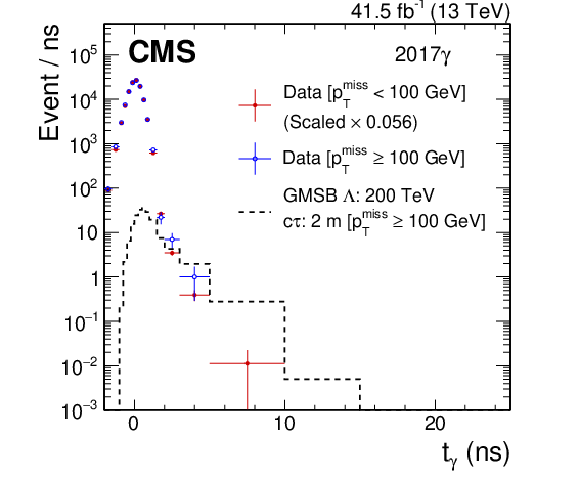
png pdf |
Figure 4-b:
The ${t_{\gamma}}$ distribution for the 2017$\gamma$ event selection shown for data and a representative signal benchmark (GMSB: $\Lambda =$ 200 TeV, ${c\tau}=$ 2 m). The ${{p_{\mathrm {T}}} ^\text {miss}}$ distribution for data is separated into events with $ {t_{\gamma}}\geq $ 1 ns (blue, darker) and $ {t_{\gamma}} < $ 1 ns (red, lighter), scaled to match the total number of events with $ {t_{\gamma}}\geq $ 1 ns. Signal (black, dotted) is shown only for events with $ {t_{\gamma}}\geq $ 1 ns. The ${t_{\gamma}}$ distribution for data is separated into events with $ {{p_{\mathrm {T}}} ^\text {miss}} \geq $ 100 GeV (blue, darker) and $ {{p_{\mathrm {T}}} ^\text {miss}} < $ 100 GeV (red, lighter), scaled to match the total number of events with $ {{p_{\mathrm {T}}} ^\text {miss}} \geq $ 100 GeV. Signal (black, dotted) is shown only for events with $ {{p_{\mathrm {T}}} ^\text {miss}} \geq $ 100 GeV. The entries in each bin are normalized by the bin width. The horizontal bars on data indicate the bin boundaries. The last bin includes overflow events. |

png pdf |
Figure 4-c:
The ${{p_{\mathrm {T}}} ^\text {miss}}$ distribution for the 2017$\gamma \gamma$ event selection shown for data and a representative signal benchmark (GMSB: $\Lambda =$ 200 TeV, ${c\tau}=$ 2 m). The ${{p_{\mathrm {T}}} ^\text {miss}}$ distribution for data is separated into events with $ {t_{\gamma}}\geq $ 1 ns (blue, darker) and $ {t_{\gamma}} < $ 1 ns (red, lighter), scaled to match the total number of events with $ {t_{\gamma}}\geq $ 1 ns. Signal (black, dotted) is shown only for events with $ {t_{\gamma}}\geq $ 1 ns. The ${t_{\gamma}}$ distribution for data is separated into events with $ {{p_{\mathrm {T}}} ^\text {miss}} \geq $ 100 GeV (blue, darker) and $ {{p_{\mathrm {T}}} ^\text {miss}} < $ 100 GeV (red, lighter), scaled to match the total number of events with $ {{p_{\mathrm {T}}} ^\text {miss}} \geq $ 100 GeV. Signal (black, dotted) is shown only for events with $ {{p_{\mathrm {T}}} ^\text {miss}} \geq $ 100 GeV. The entries in each bin are normalized by the bin width. The horizontal bars on data indicate the bin boundaries. The last bin includes overflow events. |

png pdf |
Figure 4-d:
The ${t_{\gamma}}$ distribution for the 2017$\gamma \gamma$ event selection shown for data and a representative signal benchmark (GMSB: $\Lambda =$ 200 TeV, ${c\tau}=$ 2 m). The ${{p_{\mathrm {T}}} ^\text {miss}}$ distribution for data is separated into events with $ {t_{\gamma}}\geq $ 1 ns (blue, darker) and $ {t_{\gamma}} < $ 1 ns (red, lighter), scaled to match the total number of events with $ {t_{\gamma}}\geq $ 1 ns. Signal (black, dotted) is shown only for events with $ {t_{\gamma}}\geq $ 1 ns. The ${t_{\gamma}}$ distribution for data is separated into events with $ {{p_{\mathrm {T}}} ^\text {miss}} \geq $ 100 GeV (blue, darker) and $ {{p_{\mathrm {T}}} ^\text {miss}} < $ 100 GeV (red, lighter), scaled to match the total number of events with $ {{p_{\mathrm {T}}} ^\text {miss}} \geq $ 100 GeV. Signal (black, dotted) is shown only for events with $ {{p_{\mathrm {T}}} ^\text {miss}} \geq $ 100 GeV. The entries in each bin are normalized by the bin width. The horizontal bars on data indicate the bin boundaries. The last bin includes overflow events. |

png pdf |
Figure 5:
The 95% CL exclusion contours for the GMSB neutralino production cross section, shown as functions of the neutralino mass, or equivalently the SUSY breaking scale, $\Lambda $, in the GMSB SPS8 model, and the neutralino proper decay length, $ {c\tau}_{\tilde{\chi}^0_1}$. |
| Tables | |

png pdf |
Table 1:
The fitted ECAL timing resolution parameters for the 2016 and 2017 data sets. |

png pdf |
Table 2:
The optimized bin boundaries for ${t_{\gamma}}$ (first number, in units of ns) and ${{p_{\mathrm {T}}} ^\text {miss}}$ (second number, in units of GeV), for different GMSB SPS8 signal model benchmark points considered in the search and for each data set category. |

png pdf |
Table 3:
Summary of systematic uncertainties in the analysis. Also included are notes on whether each source affects signal yields (Sig) or background (Bkg) estimates, to which bins each uncertainty applies, and how the correlations of the uncertainties between the different data sets are treated. We assign different values for the uncertainty in the closure of the background prediction for short and long lifetime signal models. The column labeled 2017 includes both the 2017$\gamma$ and 2017$\gamma \gamma$ categories. |
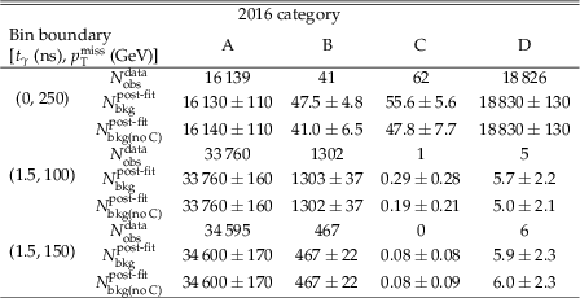
png pdf |
Table 4:
Observed number of events (${N_{\mathrm {obs}}^{\text {data}}}$) and predicted background yields from the background-only fit (${N_{\mathrm {bkg}}^{\text {post-fit}}}$) in bins A, B, C, and D in data for the 2016 category and for the different ${t_{\gamma}}$ and ${{p_{\mathrm {T}}} ^\text {miss}}$ bin boundaries summarized in Table 2. In addition, the predicted post-fit yields from the background-only fit not including bin C (${N_{\text {bkg(no C)}}^{\text {post-fit}}}$) are provided as a test of the closure. Uncertainties in the ${N_{\mathrm {bkg}}^{\text {post-fit}}}$ and ${N_{\text {bkg(no C)}}^{\text {post-fit}}}$ values are the sums in quadrature of the statistical and systematic components, with the former being dominant. |

png pdf |
Table 5:
Observed number of events (${N_{\mathrm {obs}}^{\text {data}}}$) and predicted background yields from the background-only fit (${N_{\mathrm {bkg}}^{\text {post-fit}}}$) in bins A, B, C, and D in data for the 2017$\gamma$ (upper table) and 2017$\gamma \gamma$ (lower table) categories and for the different ${t_{\gamma}}$ and ${{p_{\mathrm {T}}} ^\text {miss}}$ bin boundaries summarized in Table 2. Additional details are described in the caption of Table 4. |
| Summary |
| A search for long-lived particles that decay to a photon and a weakly interacting particle has been presented. The search is based on proton-proton collisions at a center-of-mass energy of 13 TeV collected by the CMS experiment in 2016-2017. The photon from this particle's decay would enter the electromagnetic calorimeter at non-normal impact angles and with delayed times, and this striking combination of features is exploited to suppress backgrounds. The search is performed using a combination of the 2016 and 2017 data sets, corresponding to a total integrated luminosity of 77.4 fb$^{-1}$. Both single-photon and diphoton event samples are used for the search, with each sample providing a complementary sensitivity at larger and smaller long-lived particle proper decay lengths, respectively. The results are interpreted in the context of supersymmetry with gauge-mediated supersymmetry breaking, using the SPS8 benchmark model. For neutralino proper decay lengths of 0.1, 1, 10, and 100{ m}, masses up to about 320, 525, 360, and 215 GeV are excluded at 95% confidence level, respectively. The previous best limits are extended by one order of magnitude in the neutralino proper decay length and by 100 GeV in the mass reach. |
| References | ||||
| 1 | P. Ramond | Dual theory for free fermions | PRD 3 (1971) 2415 | |
| 2 | P. Ramond | An interpretation of dual theories | Nuovo Cim. A 4 (1971) 544 | |
| 3 | \relax Yu. A. Golfand and E. P. Likhtman | Extension of the algebra of Poincar$ \'e $ group generators and violation of P invariance | JEPTL 13 (1971) 323 | |
| 4 | D. V. Volkov and V. P. Akulov | Possible universal neutrino interaction | JEPTL 16 (1972) 438 | |
| 5 | J. Wess and B. Zumino | Supergauge transformations in four-dimensions | NPB 70 (1974) 39 | |
| 6 | D. Z. Freedman, P. van Nieuwenhuizen, and S. Ferrara | Progress toward a theory of supergravity | PRD 13 (1976) 3214 | |
| 7 | S. Deser and B. Zumino | Consistent supergravity | PLB 62 (1976) 335 | |
| 8 | D. Z. Freedman and P. van Nieuwenhuizen | Properties of supergravity theory | PRD 14 (1976) 912 | |
| 9 | S. Ferrara and P. van Nieuwenhuizen | Consistent supergravity with complex spin 3/2 gauge fields | PRL 37 (1976) 1669 | |
| 10 | P. Fayet | Supergauge invariant extension of the Higgs mechanism and a model for the electron and its neutrino | NPB 90 (1975) 104 | |
| 11 | A. H. Chamseddine, R. L. Arnowitt, and P. Nath | Locally supersymmetric grand unification | PRL 49 (1982) 970 | |
| 12 | R. Barbieri, S. Ferrara, and C. A. Savoy | Gauge models with spontaneously broken local supersymmetry | PLB 119 (1982) 343 | |
| 13 | L. J. Hall, J. D. Lykken, and S. Weinberg | Supergravity as the messenger of supersymmetry breaking | PRD 27 (1983) 2359 | |
| 14 | G. L. Kane, C. F. Kolda, L. Roszkowski, and J. D. Wells | Study of constrained minimal supersymmetry | PRD 49 (1994) 6173 | hep-ph/9312272 |
| 15 | G. F. Giudice and R. Rattazzi | Theories with gauge mediated supersymmetry breaking | PR 322 (1999) 419 | hep-ph/9801271 |
| 16 | S. Dimopoulos, M. Dine, S. Raby, and S. D. Thomas | Experimental signatures of low-energy gauge mediated supersymmetry breaking | PRL 76 (1996) 3494 | hep-ph/9601367 |
| 17 | P. Fayet | Mixing between gravitational and weak interactions through the massive gravitino | PLB 70 (1977) 461 | |
| 18 | H. Baer, M. Brhlik, C. H. Chen, and X. Tata | Signals for the minimal gauge-mediated supersymmetry breaking model at the Fermilab Tevatron collider | PRD 55 (1997) 4463 | hep-ph/9610358 |
| 19 | H. Baer, P. G. Mercadante, X. Tata, and Y. L. Wang | Reach of Tevatron upgrades in gauge-mediated supersymmetry breaking models | PRD 60 (1999) 055001 | hep-ph/9903333 |
| 20 | S. Dimopoulos, S. Thomas, and J. D. Wells | Sparticle spectroscopy and electroweak symmetry breaking with gauge-mediated supersymmetry breaking | NPB 488 (1997) 39 | hep-ph/9609434 |
| 21 | J. R. Ellis, J. L. Lopez, and D. V. Nanopoulos | Analysis of LEP constraints on supersymmetric models with a light gravitino | PLB 394 (1997) 354 | hep-ph/9610470 |
| 22 | M. Dine, A. E. Nelson, Y. Nir, and Y. Shirman | New tools for low energy dynamical supersymmetry breaking | PRD 53 (1996) 2658 | hep-ph/9507378 |
| 23 | G. F. Giudice and R. Rattazzi | Gauge-mediated supersymmetry breaking | in Perspectives on supersymmetry, p. 355 World Scientific, Singapore | |
| 24 | B. C. Allanach et al. | The Snowmass points and slopes: Benchmarks for SUSY searches | EPJC 25 (2002) 113 | hep-ph/0202233 |
| 25 | C. H. Chen and J. F. Gunion | Maximizing hadron collider sensitivity to gauge mediated supersymmetry breaking models | PLB 420 (1998) 77 | hep-ph/9707302 |
| 26 | CMS Collaboration | Search for long-lived particles decaying to photons and missing energy in proton-proton collisions at $ \sqrt{s}= $ 7 TeV | PLB 722 (2013) 273 | CMS-EXO-11-035 1212.1838 |
| 27 | ATLAS Collaboration | Search for nonpointing and delayed photons in the diphoton and missing transverse momentum final state in 8 $ TeV pp $ collisions at the LHC using the ATLAS detector | PRD 90 (2014) 112005 | 1409.5542 |
| 28 | CMS Collaboration | Search for exotic decays of a Higgs boson into undetectable particles and one or more photons | PLB 753 (2016) 363 | CMS-HIG-14-025 1507.00359 |
| 29 | CMS Collaboration | The CMS experiment at the CERN LHC | JINST 3 (2008) S08004 | CMS-00-001 |
| 30 | CMS Collaboration | The CMS trigger system | JINST 12 (2017) P01020 | CMS-TRG-12-001 1609.02366 |
| 31 | J. Alwall et al. | Comparative study of various algorithms for the merging of parton showers and matrix elements in hadronic collisions | EPJC 53 (2008) 473 | 0706.2569 |
| 32 | E. Bothmann et al. | Event Generation with SHERPA 2.2 | 1905.09127 | |
| 33 | T. Gleisberg et al. | Event generation with SHERPA 1.1 | JHEP 02 (2009) 007 | 0811.4622 |
| 34 | T. Sjostrand et al. | An Introduction to PYTHIA 8.2 | CPC 191 (2015) 159 | 1410.3012 |
| 35 | P. Skands, S. Carrazza, and J. Rojo | Tuning PYTHIA 8.1: the Monash 2013 tune | EPJC 74 (2014) 3024 | |
| 36 | CMS Collaboration | Underlying event tunes and double parton scattering | CMS-PAS-GEN-14-001 | |
| 37 | CMS Collaboration | Extraction and validation of a new set of CMS PYTHIA8 tunes from underlying-event measurements | Submitted to EPJC | CMS-GEN-17-001 1903.12179 |
| 38 | NNPDF Collaboration | Parton distributions for the LHC Run II | JHEP 04 (2015) 040 | 1410.8849 |
| 39 | NNPDF Collaboration | Parton distributions from high-precision collider data | EPJC 77 (2017) 663 | 1706.00428 |
| 40 | GEANT4 Collaboration | GEANT4---a simulation toolkit | NIMA 506 (2003) 250 | |
| 41 | CMS Collaboration | Particle-flow reconstruction and global event description with the CMS detector | JINST 12 (2017) P10003 | CMS-PRF-14-001 1706.04965 |
| 42 | M. Cacciari, G. P. Salam, and G. Soyez | The anti-$ {k_{\mathrm{T}}} $ jet clustering algorithm | JHEP 04 (2008) 063 | 0802.1189 |
| 43 | M. Cacciari, G. P. Salam, and G. Soyez | FastJet user manual | EPJC 72 (2012) 1896 | 1111.6097 |
| 44 | CMS Collaboration | Performance of photon reconstruction and identification with the CMS detector in proton-proton collisions at $ \sqrt{s} = $ 8 TeV | JINST 10 (2015) P08010 | CMS-EGM-14-001 1502.02702 |
| 45 | CMS Collaboration | Jet algorithms performance in 13 TeV data | CMS-PAS-JME-16-003 | CMS-PAS-JME-16-003 |
| 46 | CMS Collaboration | Performance of missing transverse momentum reconstruction in proton-proton collisions at $ \sqrt{s} = $ 13 TeV using the CMS detector | JINST 14 (2019) P07004 | CMS-JME-17-001 1903.06078 |
| 47 | CMS Collaboration | Time Reconstruction and Performance of the CMS Electromagnetic Calorimeter | JINST 5 (2010) T03011 | CMS-CFT-09-006 0911.4044 |
| 48 | D. del Re | Timing performance of the CMS ECAL and prospects for the future | J. Phys. Conf. Ser. 587 (2015) 012003 | |
| 49 | CMS Collaboration | CMS Luminosity Measurements for the 2016 data-taking period | CMS-PAS-LUM-17-001 | CMS-PAS-LUM-17-001 |
| 50 | CMS Collaboration | CMS luminosity measurement for the 2017 data-taking period at $ \sqrt{s} = $ 13 TeV | CMS-PAS-LUM-17-004 | CMS-PAS-LUM-17-004 |
| 51 | T. Junk | Confidence level computation for combining searches with small statistics | NIMA 434 (1999) 435 | hep-ex/9902006 |
| 52 | A. L. Read | Presentation of search results: The $ CL_{s} $ technique | JPG 28 (2002) 2693 | |
| 53 | The ATLAS Collaboration, The CMS Collaboration, The LHC Higgs Combination Group | Procedure for the LHC Higgs boson search combination in Summer 2011 | CMS-NOTE-2011-005 | |

|
Compact Muon Solenoid LHC, CERN |

|

|

|

|

|

|